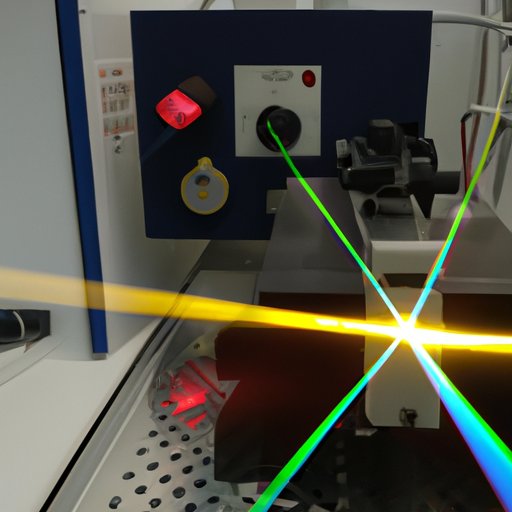Introduction
Lasers are powerful tools that have revolutionized a wide range of applications in science, industry, and medicine. But what is a laser and how does it work? This article will explore the basics of laser technology, including how lasers generate and focus light, the components of a laser system, and the various applications of lasers. We will also investigate potential safety concerns associated with laser usage.
Exploring the Basics of Laser Technology
A laser is a device that produces a concentrated beam of coherent light. Coherent light means that all the waves of light emitted from the laser are in phase with each other, meaning that they all have the same frequency and wavelength. Lasers produce light by stimulating atoms to emit photons, which is the basic unit of light.
There are many different types of lasers, which can be classified based on their wavelength and energy output. For example, there are infrared lasers, visible lasers, ultraviolet lasers, and X-ray lasers. The most commonly used lasers are gas lasers, solid-state lasers, semiconductor lasers, and dye lasers.
The basic principle behind how a laser works is straightforward. A source of energy, such as electricity or light, is used to stimulate atoms within a gain medium. These atoms then emit photons, which are amplified and eventually focused into a narrow beam of light. This process is known as stimulated emission.

How Lasers Emit and Focus Light
To understand how lasers generate and focus light, it is important to first understand the role of mirrors in this process. Mirrors are used to reflect the light emitted from the laser back into the gain medium, where it is amplified. This is known as optical feedback. By carefully controlling the shape and angle of the mirrors, the laser light can be focused into a narrow beam.
Once the light has been reflected back into the gain medium, it is amplified by the stimulated emission process. This process causes the light to become more intense and focused into a narrow beam. This beam of light is then directed out of the laser system through an aperture, where it can be used for various applications.
The Components of a Laser System
A laser system consists of three main components: the laser source, optics, and the beam delivery system. The laser source is the device that generates the laser light. This can be a gas laser, a solid-state laser, a semiconductor laser, or a dye laser. The optics are responsible for directing and focusing the light into a narrow beam. Finally, the beam delivery system is used to transport the beam of light to its destination. This could be an optical fiber, a lens, or a mirror.

Examining the Applications of Lasers
Lasers are used in a variety of applications, including medical, industrial, and scientific research. In medicine, lasers are used for a number of procedures, such as laser eye surgery, laser hair removal, and laser skin resurfacing. In industry, lasers are used for cutting, welding, marking, and engraving materials. In scientific research, lasers are used to measure distances, detect molecules, and study the properties of light.

Investigating the Safety Concerns of Laser Usage
While lasers are incredibly useful tools, they can also be dangerous if not used properly. Laser light can cause permanent damage to the eyes, as well as burns and skin irritation. Therefore, it is important to take proper safety precautions when using lasers. This includes wearing protective eyewear, avoiding direct exposure to the beam, and ensuring that all personnel are aware of the potential hazards associated with laser use.
Conclusion
Lasers are powerful tools that have revolutionized a wide range of applications in science, industry, and medicine. By understanding the basics of laser technology, including how lasers generate and focus light, the components of a laser system, and the various applications of lasers, we can better appreciate the incredible potential of these devices. However, it is important to remember the potential hazards associated with laser use and take appropriate safety measures.
(Note: Is this article not meeting your expectations? Do you have knowledge or insights to share? Unlock new opportunities and expand your reach by joining our authors team. Click Registration to join us and share your expertise with our readers.)
